Skin cancer is a serious health issue that affects millions globally. Knowing the signs early can save lives. This guide helps you understand what skin cancer looks like and how to spot it. Skin cancer can show up in many ways, from small mole changes to obvious growths. We’ll look at the different types of skin cancer and their signs. Learning about these symptoms helps you catch problems early and get medical help fast.
Early detection is key to beating skin cancer. If you see any unusual skin changes or worry about a spot, see a dermatologist. They can give you a professional check-up.
Understanding the Basics of Skin Cancer
Skin cancer is a serious health issue that affects millions globally. Knowing the basics helps protect you and spot problems early. Let’s dive into the key points of this condition.
Types of Skin Cancer
There are three main skin cancer types you should know:
- Basal cell carcinoma
- Squamous cell carcinoma
- Melanoma
Each type has its own traits and treatment needs. Basal and squamous cell carcinomas are common but less serious. Melanoma is rarer but can be deadly if not caught soon.
Risk Factors and Causes
Several factors increase your risk of skin cancer:
- Excessive sun exposure
- Fair skin
- History of sunburns
- Family history of skin cancer
- Weakened immune system
Common Areas Where Skin Cancer Develops
Skin cancer often shows up in sun-exposed areas:
- Face and neck
- Arms and hands
- Chest and back
- Legs and feet
Regular skin checks are key for early detection. Watch these areas closely and any mole changes or new growths. Knowing these basics helps you take steps to prevent and detect skin cancer.
What Does Skin Cancer Look Like: Key Visual Indicators
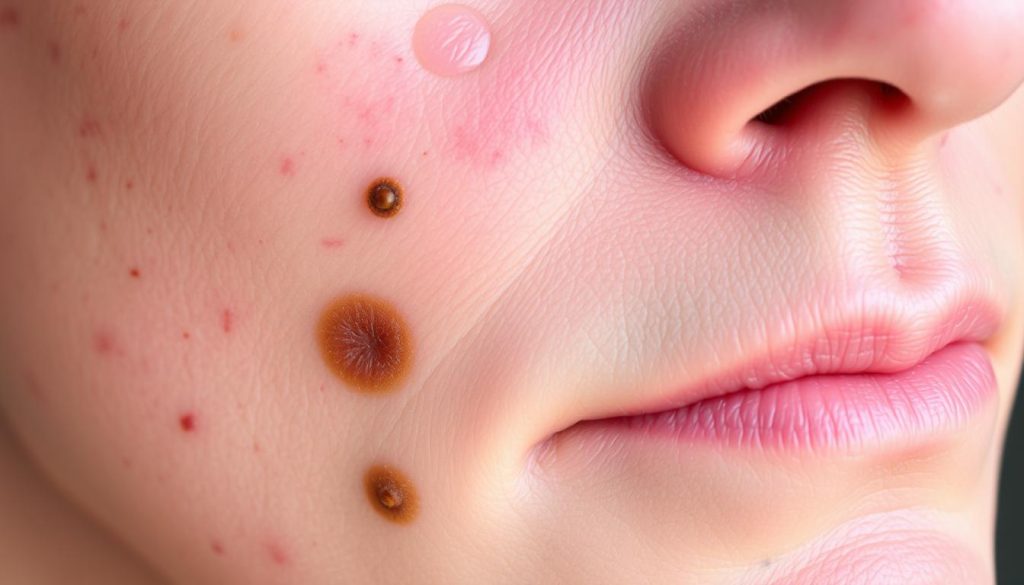
It’s vital to spot skin cancer early. It can show up as unusual growths or changes in skin marks. Here are the main signs to watch for.
Skin cancer moles often stand out. They might be odd in shape, size, or color. Look for moles that are not symmetrical or have uneven edges. If a mole looks different or changes, see a dermatologist.
Skin cancer lesions can be new growths or changes in existing marks. They might be raised, flat, or scaly. Colors can range from flesh-toned to red, brown, or black. Some might bleed easily or not heal.
Skin cancer can also cause discoloration. This shows as patches that are darker, lighter, or redder than the rest. These areas might itch, scale, or bleed.
| Visual Indicator | Description | Associated Cancer Type |
|---|---|---|
| Pearly bump | Smooth, shiny growth | Basal cell carcinoma |
| Scaly patch | Rough, red, or pink lesion | Squamous cell carcinoma |
| Dark spot | New or changing pigmented area | Melanoma |
Not all skin changes mean cancer, but it’s wise to check them out. Doing regular skin self-exams helps you know what’s normal. This way, you can spot problems early.
The ABCDE Rule for Melanoma Detection
The ABCDE rule is key for finding melanoma. It helps spot skin lesions that could be cancer. Let’s look at each part of this important rule.
Asymmetry in Skin Lesions
See if your mole or growth is even on both sides. Cancerous ones often look irregular. If you draw a line down the middle, the halves should match. If they don’t, it’s a warning sign.
Border Irregularities
Healthy moles have smooth, even edges. Melanomas have jagged or notched borders. Watch for any odd patterns on your skin.
Color Variations
Normal moles are usually one color. Melanomas can have different colors or shades. Look for spots with various colors like brown, black, red, white, or blue.
Diameter Concerns
Size is important in finding melanomas. Most are over 6 millimeters (like a pencil eraser). But, they can start small, so watch for any growths.
Evolution and Changes Over Time
Notice any changes in your skin lesions. This includes size, shape, color, or new symptoms like itching or bleeding. Regular checks can help track these changes.
Remember, the ABCDE rule is just a guide. If you see something odd, see a dermatologist for a proper check.
Basal Cell Carcinoma Appearance and Characteristics
Basal cell carcinoma is the most common skin cancer. It’s important to know its signs for early treatment. This cancer often shows up on sun-exposed areas.
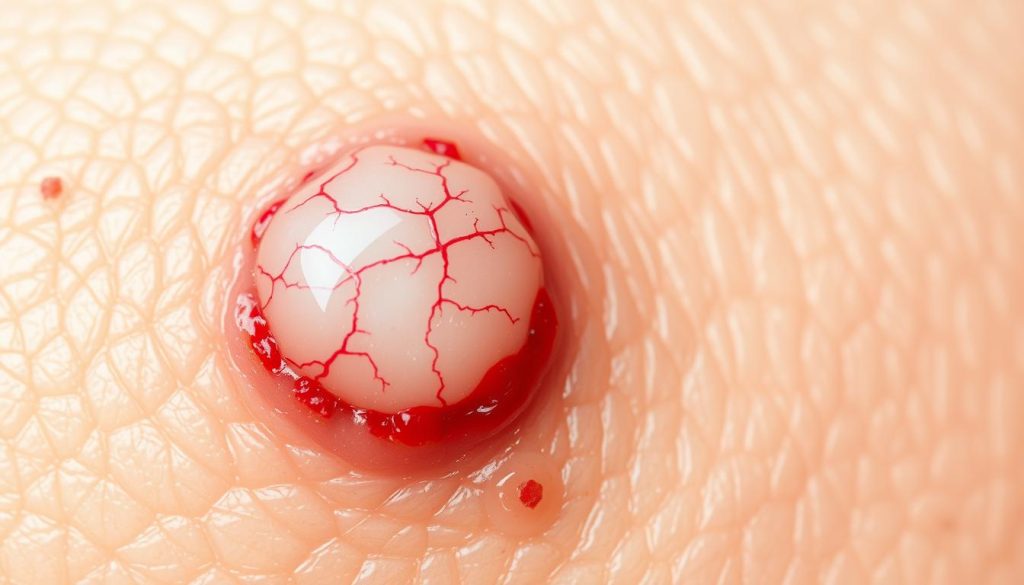
- Pearly, waxy bumps
- Flat, flesh-colored or brown lesions
- Bleeding or scabbing sores that heal and return
These growths often appear on the face, ears, and neck. They can also show up on the chest, abdomen, and legs. Basal cell carcinoma grows slowly, so changes might be hard to notice at first.
One key sign is the rolled border of these lesions. This can help tell them apart from other skin issues. Early detection of skin cancer is key for good treatment results.
If you see any unusual skin changes, see a dermatologist right away. Regular skin checks can catch basal cell carcinoma early. This can greatly improve treatment success.
Identifying Squamous Cell Carcinoma Signs
It’s important to spot squamous cell carcinoma early. This skin cancer often shows up on sun-exposed parts. It can look different.
Early Warning Signs
Look out for rough, scaly patches that bleed easily. These patches might be red or pink and feel sore. They can look like warts or sores that won’t heal.
Advanced Stage Appearances
As it grows, squamous cell carcinoma can form bigger, raised growths. These have a crusty look and might hurt. In later stages, it can dig deep into the skin, causing noticeable changes.
Common Locations
Squamous cell carcinoma often shows up where the sun hits most. Here’s where it’s most common:
| Body Area | Frequency | Notable Features |
|---|---|---|
| Face and ears | Very high | Often on nose, cheeks, and ear rims |
| Neck and hands | High | Backs of hands are very vulnerable |
| Scalp (bald areas) | Moderate | More common in men with hair loss |
| Arms and legs | Moderate | Can happen on any limb part |
| Lips | Less common | Often mistaken for chapped lips at first |
Watching for skin cancer signs, mainly in these spots, helps catch it early. Regular skin checks and quick action for any growths are vital in fighting squamous cell carcinoma.
Melanoma: The Most Dangerous Form
Melanoma is the most aggressive type of skin cancer. It develops in melanocytes, the cells that give skin its color. Catching it early is key to treating it successfully, as it can spread fast if not treated.
The symptoms of melanoma can be tricky to spot. It might look like a new mole or a change in an old one. It can show up anywhere on the body, even in places not usually in the sun.
Spotting the signs of melanoma early is very important. Here are some key signs to look out for:
- Asymmetrical shape
- Irregular borders
- Multiple colors within one lesion
- Diameter larger than 6mm
- Evolution or changes over time
Anyone can get melanoma, but some are at higher risk. These include people with fair skin, a history of sunburns, too much UV exposure, and a family history of skin cancer.
| Melanoma Type | Characteristics | Common Location |
|---|---|---|
| Superficial Spreading | Flat or slightly raised, irregular shape | Trunk, legs, arms |
| Nodular | Lumpy, fast-growing | Anywhere on the body |
| Lentigo Maligna | Flat, tan or brown | Sun-exposed areas in older adults |
| Acral Lentiginous | Dark spot or patch | Palms, soles, under nails |
Regular skin checks and quick action for any suspicious spots are key to fighting this serious cancer. Remember, catching it early can greatly improve treatment chances for melanoma patients.
Non-Melanoma Skin Cancer Visual Guide
It’s important to know about non-melanoma skin cancer for early detection and treatment. This guide helps you spot unusual skin growths and identify signs of skin cancer.
Physical Characteristics
Non-melanoma skin cancers often look like shiny, pearly bumps or flat, scaly patches. They can be pink, red, or brown in color.
Growth Patterns
These cancers grow slowly. You might see a small bump get bigger or a patch of skin become more raised. Some may bleed easily or form a crust that doesn’t heal.
Surface Changes
Look for changes in the skin’s texture. Non-melanoma skin cancers can make the skin rough, scaly, or form small ulcers. Sometimes, they look like craters in the center.
| Type | Appearance | Common Locations |
|---|---|---|
| Basal Cell Carcinoma | Pearly, waxy bump; flat, flesh-colored lesion | Face, ears, neck |
| Squamous Cell Carcinoma | Red, scaly patch; firm, red nodule | Sun-exposed areas, lips, hands |
If you notice any unusual skin growths, see a healthcare professional. Regular skin checks can help find non-melanoma skin cancer early, leading to better treatment outcomes.
Early Detection Through Regular Skin Checks
Regular skin checks are key in catching skin cancer early. By checking your skin every month, you can spot changes quickly. This way, you can get medical help if needed. Self-exams and professional screenings work together to keep you healthy.
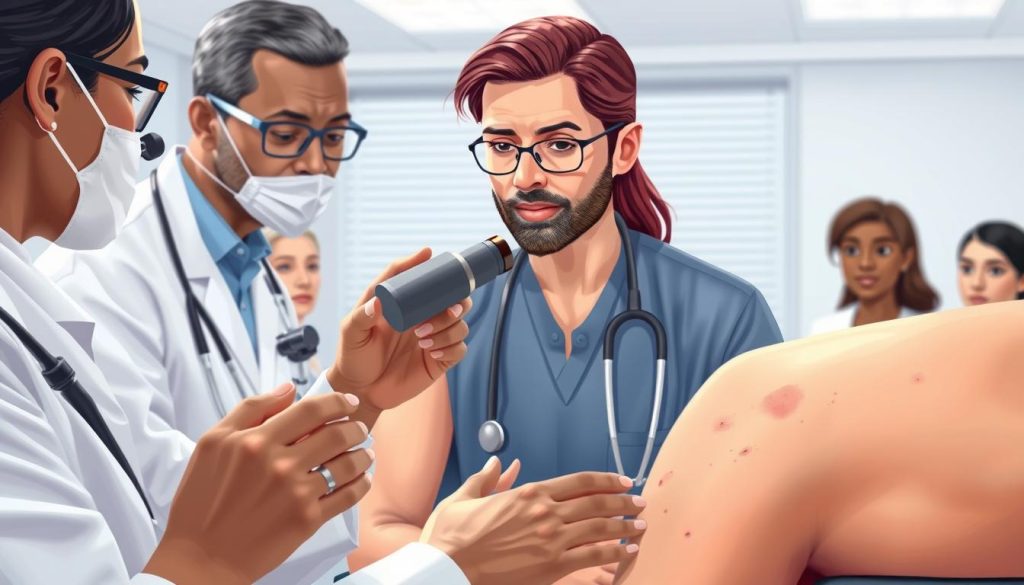
- Check your entire body, including hard-to-see areas
- Use mirrors for a better view of your back and scalp
- Look for new moles or changes in existing ones
- Note any unusual spots, bumps, or sores
- Pay attention to areas that get sun exposure
Professional skin cancer screenings are also vital. Dermatologists use special tools and methods to check your skin. They can find suspicious spots that self-exams might miss.
| Self-Exam | Professional Screening |
|---|---|
| Monthly | Annually or as recommended |
| At home | At a dermatologist’s office |
| Visual inspection | Visual and dermatoscopic examination |
| No special equipment needed | Uses specialized tools |
Early detection of skin cancer greatly improves treatment success. By doing regular self-exams and getting professional screenings, you actively protect your skin health.
Unusual Skin Growths and When to Worry
It’s key to spot abnormal skin changes early to catch skin cancer. Most moles are fine, but knowing the odd ones is vital.
Normal vs. Suspicious Moles
Normal moles are round or oval, with smooth edges and even color. They don’t change much over time. But, moles that might be cancerous often look different and grow.
| Normal Moles | Suspicious Moles |
|---|---|
| Symmetrical shape | Asymmetrical shape |
| Smooth, even borders | Irregular, jagged borders |
| Uniform color | Multiple colors or uneven pigmentation |
| Smaller than 6mm in diameter | Larger than 6mm in diameter |
| Stable appearance over time | Changes in size, shape, or color |
Warning Signs to Watch For
Look out for these signs that might mean skin cancer:
- A new mole or growth that appears after age 30
- A mole that itches, bleeds, or feels painful
- Rapid changes in a mole’s size, shape, or color
- A sore that doesn’t heal within a few weeks
- A mole with an unusual texture or surface
If you see any of these signs, see a dermatologist right away. Checking your skin regularly can help find new moles early.
Skin Cancer in Different Skin Tones
Skin cancer doesn’t discriminate. It can affect people of all skin tones, but its appearance can vary. Understanding these differences is key for early detection and treatment.
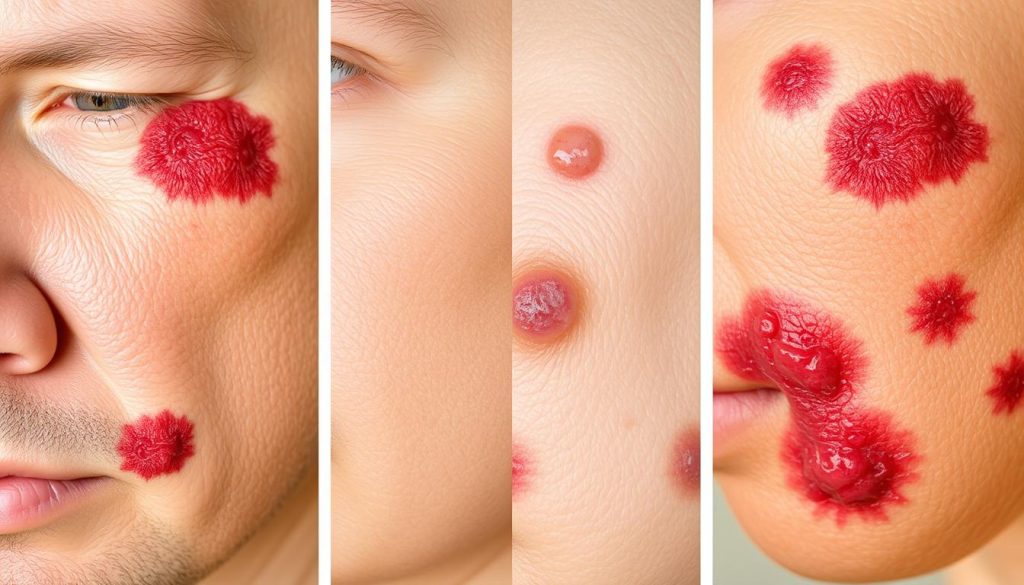
In lighter skin, skin cancer symptoms often appear as reddish or pinkish patches. These may be scaly or rough to the touch. On darker skin, these same lesions might look brown or black. The key is to watch for any new or changing spots.
Melanoma, the most dangerous form of skin cancer, can be trickier to spot on darker skin. It may hide in less obvious places like the palms, soles of feet, or under nails. Regular full-body checks are essential for everyone, regardless of skin tone.
Skin cancer appearances can include:
- Dark patches or streaks under nails
- Sores that don’t heal
- Rough or scaly patches
- Moles that change size, shape, or color
Don’t ignore unusual skin changes. If you notice anything suspicious, consult a dermatologist promptly. Early detection saves lives, no matter your skin tone. Remember, everyone needs sun protection to reduce skin cancer risk.
Common Skin Cancer Locations on the Body
Knowing where skin cancer often shows up can help find it early. Different spots are more likely to get it because of the sun and other reasons. Let’s look at the usual places for skin cancer.
Face and Neck Areas
The face and neck get a lot of sun, making them high-risk areas. Look for odd spots on your nose, cheeks, ears, and lips. Also, check your scalp, even if your hair is thinning.
Trunk and Extremities
Lesions can pop up on your chest, arms, and legs. Make it a habit to check your shoulders, back, and chest. Women should watch their lower legs, while men should check their backs.
Hidden Areas to Check
Some skin cancers hide in less obvious spots. Look between your toes, under your nails, and on your feet’s soles. Even places that don’t get much sun can have cancer.
| Body Area | Common Skin Cancer Types | Risk Level |
|---|---|---|
| Face | Basal Cell, Squamous Cell | High |
| Neck | Melanoma, Basal Cell | High |
| Arms | Squamous Cell, Melanoma | Medium |
| Legs | Melanoma (women) | Medium |
| Back | Melanoma (men) | High |
While these are common spots, skin cancer can show up anywhere. Regular body checks and doctor visits are vital for early detection.
Documentation and Tracking Changes
Keeping a record of skin changes is key for spotting skin cancer early. By tracking abnormal skin changes over time, you boost your chances of catching issues early.
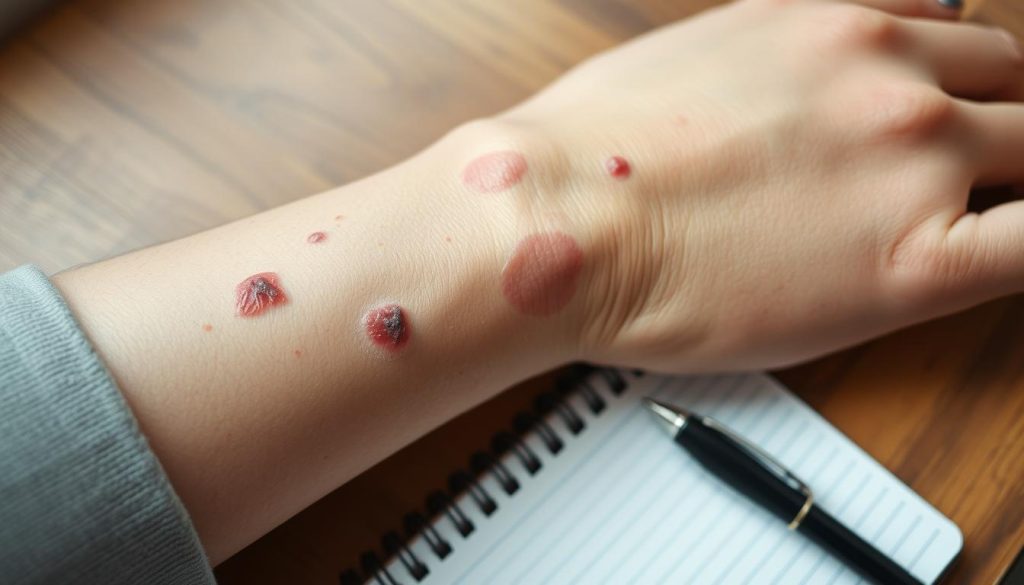
Photography is a great way to monitor your skin. Take clear, well-lit photos of any moles, freckles, or lesions you’re worried about. Make sure to capture these images from different angles and include a ruler for size reference.
Digital tools can also help in skin cancer detection. Many smartphone apps let you upload and organize photos of your skin. This makes it easier to track changes over time. Some apps even use artificial intelligence to analyze images and flag possible concerns.
When documenting skin changes, pay attention to:
- Size: Measure the diameter of moles or lesions
- Color: Note any variations or changes in pigmentation
- Shape: Observe the borders and overall symmetry
- Texture: Feel for any raised areas or changes in smoothness
- Symptoms: Record any itching, bleeding, or pain
By consistently tracking these factors, you create a valuable record for your dermatologist. This info is key in deciding if a biopsy or further exam is needed. Remember, early detection is key in successful skin cancer treatment.
Professional Skin Cancer Screening Guidelines
Regular skin cancer screenings are key for catching it early. The American Academy of Dermatology suggests annual full-body skin exams for adults. If you have fair skin, often get sunburned, or have a family history of skin cancer, you might need more frequent checks.
A dermatologist will examine your whole body during a screening. They look for any moles, growths, or skin changes that seem off. They might use special tools like a dermatoscope to get a closer look. This detailed check helps find skin cancers early, when they’re easier to treat.
It’s also important to do monthly self-exams. Check for any new or changing spots on your skin. If you find something unusual, don’t wait for your next appointment. Call your healthcare provider right away. Early detection of skin cancer can save lives.
FAQ
Q: What are the most common visual signs of skin cancer?
A: Look out for unusual moles or growths, changes in existing moles, sores that don’t heal, and patches of skin that are red, scaly, or itchy. The ABCDE signs are key: Asymmetry, irregular Borders, uneven Color, large Diameter, and Evolving appearance.
Q: How can I tell if a mole is cancerous?
A: Use the ABCDE rule to check if a mole might be cancerous. Look for Asymmetry, irregular Borders, uneven Color, large Diameter, and Evolving changes. If you notice these signs, see a dermatologist.
Q: What does basal cell carcinoma look like?
A: Basal cell carcinoma often looks like a pearly or waxy bump, a flat, flesh-colored or brown scar-like lesion, or a bleeding or scabbing sore that heals and returns. It’s usually found on sun-exposed areas like the face and neck.
Q: How does squamous cell carcinoma appear?
A: Squamous cell carcinoma looks like a red, scaly patch, an open sore, or a wart-like growth. It may crust or bleed and can appear as an elevated growth with a central depression. These lesions are often found on sun-exposed areas of the body.
Q: What are the visual characteristics of melanoma?
A: Melanoma often looks like an unusual mole or pigmented patch of skin. It may be asymmetrical, have irregular borders, show multiple colors, be larger than 6mm in diameter, and evolve or change over time. Melanomas can occur anywhere on the body, including areas not typically exposed to the sun.
Q: Can skin cancer occur in people with darker skin tones?
A: Yes, skin cancer can occur in people of all skin tones. In darker skin, it may appear differently and can be harder to detect. Look for dark spots, patches, or growths that are changing, growing, or bleeding. Skin cancer in people of color often appears on areas less exposed to the sun, such as the palms, soles, and under nails.
Q: How often should I perform skin self-examinations?
A: Perform skin self-examinations monthly. This regular check helps you become familiar with your skin’s normal appearance and makes it easier to spot any new or changing lesions. Use a full-length mirror and handheld mirror to examine all areas of your body, including hard-to-see spots.
Q: Are all unusual skin growths cancerous?
A: No, not all unusual skin growths are cancerous. Many benign (non-cancerous) growths can look similar to skin cancer. It’s important to have any new, changing, or suspicious growths evaluated by a dermatologist to rule out skin cancer.
Q: What are some hidden areas where skin cancer can develop?
A: Skin cancer can develop in areas not typically exposed to the sun. Some hidden areas to check include between toes, under nails, on the scalp, behind the ears, on the soles of feet, in the genital area, and inside the mouth. Regular thorough checks of these areas are important for early detection.
Q: How can I document changes in my skin for better tracking?
A: To document skin changes effectively, consider taking clear, well-lit photos of concerning areas. Use a ruler or coin for scale. Some smartphone apps are designed for skin monitoring, allowing you to track changes over time. Keep a log of when you noticed the change and any symptoms. This documentation can be valuable when consulting with a dermatologist.

















